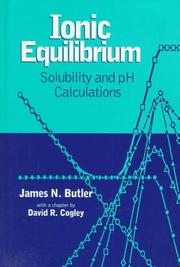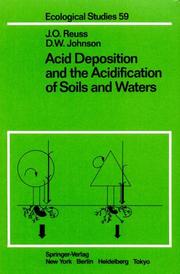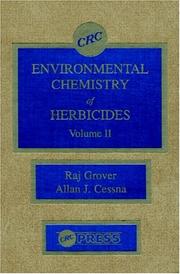| Listing 1 - 10 of 13 | << page >> |
Sort by
|

ISBN: 0471585262 Year: 1998 Publisher: New York, N.Y. John Wiley
Abstract | Keywords | Export | Availability | Bookmark
 Loading...
Loading...Choose an application
- Reference Manager
- EndNote
- RefWorks (Direct export to RefWorks)
Ionic equilibrium --- #WSCH:AAS2 --- 541.132.3 --- 66-915 --- 541.132.3 Hydrogen ion concentration (pH) --- Hydrogen ion concentration (pH) --- 66-915 pH value --- pH value --- Equilibrium, Ionic --- Ionization --- Electrochemistry --- Physicochemistry --- electrochemistry --- pH-metrie --- ionen --- fysicochemie --- elektrochemie
Book
ISBN: 3540507825 3642744443 3642744427 9783540507826 Year: 1991 Publisher: Berlin Springer
Abstract | Keywords | Export | Availability | Bookmark
 Loading...
Loading...Choose an application
- Reference Manager
- EndNote
- RefWorks (Direct export to RefWorks)
Soil acidity --- Sol acide --- Acid soils --- Acidification --- Facteur édaphique --- Edaphic factors --- Écosystème --- ecosystems --- Population végétale --- plant population --- Aluminium --- Équilibre acidobasique --- Acid base equilibrium --- #KVIV:BB --- 631.415 --- Soil reaction. Soil acidity and alkalinity. Hydrogen ion concentration in soil (pH value) --- 631.415 Soil reaction. Soil acidity and alkalinity. Hydrogen ion concentration in soil (pH value)

ISBN: 0387962905 3540962905 1461264294 1441985360 9783540962908 9780387962900 Year: 1986 Volume: 59 Publisher: New York (N.Y.) Springer
Abstract | Keywords | Export | Availability | Bookmark
 Loading...
Loading...Choose an application
- Reference Manager
- EndNote
- RefWorks (Direct export to RefWorks)
Air pollution. Air purification --- Soil pollution. Soil purification --- Water supply. Water treatment. Water pollution --- 631.415 --- Acid deposition --- -Soil acidification --- Acidification --- Acidic deposition --- Deposition, Acid --- Pollutants --- Soil reaction. Soil acidity and alkalinity. Hydrogen ion concentration in soil (pH value) --- Environmental aspects --- 631.415 Soil reaction. Soil acidity and alkalinity. Hydrogen ion concentration in soil (pH value) --- Soil acidification --- Acid deposition - Environmental aspects --- COMPUTERIZED SIMULATION --- FOREST ECOLOGY --- SOLUTIONS (CHIMIE) --- NITROGEN CYCLE --- SULFUR CYCLE --- WATER --- SOILS --- ACIDIFICATION --- ACID PRECIPITATION --- INTERACTIONS

ISBN: 0471056472 9780471056478 Year: 1973 Publisher: New York (N.Y.): Wiley
Abstract | Keywords | Export | Availability | Bookmark
 Loading...
Loading...Choose an application
- Reference Manager
- EndNote
- RefWorks (Direct export to RefWorks)
fysicochemie --- Electrochemistry --- Hydrogen-ion concentration --- Electrochimie --- Measurement --- Hydrogen-Ion Concentration. --- 543.257.1 --- -#WSCH:AAS1 --- #WSCH:AAS3 --- Hydrogen-ion activity --- pH (Chemistry) --- Acidity function --- Chemistry, Physical and theoretical --- Potentiometric analysis. Determination of hydrogen ion concentration. pH value --- Waterstofionenconcentratie --- Waterstofionenconcentratie. --- 543.257.1 Potentiometric analysis. Determination of hydrogen ion concentration. pH value --- Hydrogen-Ion Concentration --- #WSCH:AAS1 --- pH --- Concentration, Hydrogen-Ion --- Concentrations, Hydrogen-Ion --- Hydrogen Ion Concentration --- Hydrogen-Ion Concentrations --- Acid-Base Equilibrium --- Proton-Motive Force --- Hydrogen --- Analysis --- Hydrogen-ion concentration - Measurement --- Acids --- Bases

ISBN: 0849343763 0849343771 Year: 1988 Publisher: Boca Raton CRC Press
Abstract | Keywords | Export | Availability | Bookmark
 Loading...
Loading...Choose an application
- Reference Manager
- EndNote
- RefWorks (Direct export to RefWorks)
Herbiciden --- 632.954 --- 504.4.054 --- 631.415 --- 504.53 Earth surface. Soil environment --- Earth surface. Soil environment --- 631.415 Soil reaction. Soil acidity and alkalinity. Hydrogen ion concentration in soil (pH value) --- Soil reaction. Soil acidity and alkalinity. Hydrogen ion concentration in soil (pH value) --- Herbicide content --- -Herbicide --- 631.43 --- 504.53 --- Environmental chemistry --- Herbicides --- -Soils --- Weed killers --- Weedicides --- Pesticides --- Weeds --- Chemistry, Environmental --- Chemistry --- Ecology --- 631.43 Physical and mechanical properties of soil --- Physical and mechanical properties of soil --- 632.954 Herbicides. Weedkillers --- Herbicides. Weedkillers --- Earth (Soils) --- Mold, Vegetable --- Mould, Vegetable --- Soil --- Vegetable mold --- Agricultural resources --- Plant growing media --- Regolith --- Land capability for agriculture --- Environmental aspects --- Control --- Soils --- Herbicides. --- Herbicides - Environmental aspects. --- Soils - Herbicide content. --- Environmental chemistry. --- -Earth (Soils) --- Herbicide --- -Environmental aspects
Book
ISBN: 0471913928 0471913936 9780471913931 Year: 1987 Publisher: Chichester Wiley & Sons
Abstract | Keywords | Export | Availability | Bookmark
 Loading...
Loading...Choose an application
- Reference Manager
- EndNote
- RefWorks (Direct export to RefWorks)
For many chemists, potentiometry is the first analytical procedure that they encounter, during the use of an electrode to measure pH. The advances in the field of ion selective electrodes now make it a valuable technique in the modern analytical laboratory.
Analytische chemie: elektrochemie --- Potentiometrie --- Chemistry, Analytic --- Electrodes, Ion selective --- Potentiometry --- Basic Sciences. Chemistry --- Programmed instruction. --- Analytical Chemistry. --- 544.6 --- analytische chemie (scheikunde) --- elektrochemie --- elektroden --- fysicochemische analyse --- fysische chemie --- ionen --- potentiometrie --- Potentiometric analysis --- Potentiometric titration --- Titration, Potentiometric --- Electrochemical analysis --- Ion selective electrodes --- Ion sensitive electrodes --- Specific ion electrodes --- Electrodes --- Ion-permeable membranes --- Programmed instruction --- Analytical methods --- fysicochemie --- analytische chemie --- 543.1 --- 543.544 --- Analytische chemie --- Ion-selectieve elektroden --- 543.257.1 --- 543.257.1 Potentiometric analysis. Determination of hydrogen ion concentration. pH value --- Potentiometric analysis. Determination of hydrogen ion concentration. pH value --- Chimie analytique --- Enseignement programmé --- Analytical chemistry --- Analysis, Chemical --- Analytic chemistry --- Chemical analysis --- Chemistry --- Potentiometry - Programmed instruction --- Electrodes, Ion selective - Programmed instruction --- Chemistry, Analytic - Programmed instruction --- Open learning --- Electrode ion selective --- Electrodes, Ion selective. --- Potentiometry. --- Analytical methods. --- Électrodes sélectives d'ions. --- Potentiométrie. --- Enseignement programmé.
Book

ISBN: 0891188037 9780891188032 Year: 1993 Volume: 32 Publisher: Madison Soil science society of America
Abstract | Keywords | Export | Availability | Bookmark
 Loading...
Loading...Choose an application
- Reference Manager
- EndNote
- RefWorks (Direct export to RefWorks)
Soils --- Pesticides --- Organic compounds --- Pesticide content --- Congresses. --- Organic compound content --- Biodegradation --- 631.414.3 --- 631.415 --- Earth (Soils) --- Mold, Vegetable --- Mould, Vegetable --- Soil --- Vegetable mold --- Agricultural resources --- Plant growing media --- Regolith --- Land capability for agriculture --- Economic poisons --- Agricultural chemicals --- Pests --- Poisons --- Compounds, Organic --- Organic chemicals --- Carbon compounds --- 631.414.3 Absorption. Adsorption --- Absorption. Adsorption --- 631.415 Soil reaction. Soil acidity and alkalinity. Hydrogen ion concentration in soil (pH value) --- Soil reaction. Soil acidity and alkalinity. Hydrogen ion concentration in soil (pH value) --- Biodegradation&delete& --- Congresses --- Organic compound content&delete& --- Pesticide content&delete& --- Control --- Equipment and supplies --- Conferences - Meetings --- Soils - Pesticide content - Congresses. --- Soils - Organic compound content - Congresses. --- Pesticides - Biodegradation - Congresses. --- Organic compounds - Biodegradation - Congresses.
Book
Year: 2020 Publisher: Basel, Switzerland MDPI - Multidisciplinary Digital Publishing Institute
Abstract | Keywords | Export | Availability | Bookmark
 Loading...
Loading...Choose an application
- Reference Manager
- EndNote
- RefWorks (Direct export to RefWorks)
With recent technological advances in multiple research fields such as materials science, micro-/nano-technology, cellular and molecular biology, bioengineering and the environment, much attention is shifting toward the development of new detection tools that not only address needs for high sensitivity and specificity but fulfil economic, environmental, and rapid point-of-care needs for groups and individuals with constrained resources and, possibly, limited training. Miniaturized fluidics-based platforms that precisely manipulate tiny body fluid volumes can be used for medical, healthcare or even environmental (e.g., heavy metal detection) diagnosis in a rapid and accurate manner. These new detection technologies are potentially applicable to different healthcare or environmental issues, since they are disposable, inexpensive, portable, and easy to use for the detection of human diseases or environmental issues—especially when they are manufactured based on low-cost materials, such as paper. The topics in this book (original and review articles) would cover point-of-care detection devices, microfluidic or paper-based detection devices, new materials for making detection devices, and others.
History of engineering & technology --- sepsis --- PCT --- procalcitonin --- immunoassay --- antibiotic --- chemiluminescence --- immunofluorescence --- n/a --- origami-based paper analytic device --- origami ELISA --- IgG --- paraquat --- diabetes mellitus --- ketone bodies --- human breath --- acetone --- beta-hydroxybutyrate --- acetoacetate --- gas chromatography-mass spectrometry (GC-MS) --- type 2 diabetes --- diabetic peripheral neuropathy (DPN) --- electrocardiogram (ECG) --- photoplethysmography (PPG) --- percussion entropy index (PEI) --- decision making, computer-assisted --- decision support systems, clinical --- precision medicine --- computational biology --- molecular tumor board --- cBioPortal --- requirements analysis --- neoplasms --- pH value --- diagnosis --- skin --- wound --- blood --- coagulation --- hemostasis --- point of care --- ROTEM --- TEG --- thromboelastography --- VHA --- viscoelastic testing --- partial-thickness burn injury --- burn blister fluid --- P-ELISA --- angiogenin --- burn wound healing --- Alzheimer’s disease --- β-amyloid peptide --- paper-based ELISA --- P-ELISA, point of care testing --- microfluidics --- point-of-care diagnostics --- antimicrobial resistance --- lab-on-a-chip --- capillary-driven flow --- capillary action --- detections --- smartphone imaging --- lateral flow assay --- immuno-chromatographic --- gold nanoparticles sensor --- UV/Vis spectrophotometer --- malaria pan rapid diagnostic strip --- point-of-care --- Alzheimer's disease
Book
Year: 2020 Publisher: Basel, Switzerland MDPI - Multidisciplinary Digital Publishing Institute
Abstract | Keywords | Export | Availability | Bookmark
 Loading...
Loading...Choose an application
- Reference Manager
- EndNote
- RefWorks (Direct export to RefWorks)
With recent technological advances in multiple research fields such as materials science, micro-/nano-technology, cellular and molecular biology, bioengineering and the environment, much attention is shifting toward the development of new detection tools that not only address needs for high sensitivity and specificity but fulfil economic, environmental, and rapid point-of-care needs for groups and individuals with constrained resources and, possibly, limited training. Miniaturized fluidics-based platforms that precisely manipulate tiny body fluid volumes can be used for medical, healthcare or even environmental (e.g., heavy metal detection) diagnosis in a rapid and accurate manner. These new detection technologies are potentially applicable to different healthcare or environmental issues, since they are disposable, inexpensive, portable, and easy to use for the detection of human diseases or environmental issues—especially when they are manufactured based on low-cost materials, such as paper. The topics in this book (original and review articles) would cover point-of-care detection devices, microfluidic or paper-based detection devices, new materials for making detection devices, and others.
sepsis --- PCT --- procalcitonin --- immunoassay --- antibiotic --- chemiluminescence --- immunofluorescence --- n/a --- origami-based paper analytic device --- origami ELISA --- IgG --- paraquat --- diabetes mellitus --- ketone bodies --- human breath --- acetone --- beta-hydroxybutyrate --- acetoacetate --- gas chromatography-mass spectrometry (GC-MS) --- type 2 diabetes --- diabetic peripheral neuropathy (DPN) --- electrocardiogram (ECG) --- photoplethysmography (PPG) --- percussion entropy index (PEI) --- decision making, computer-assisted --- decision support systems, clinical --- precision medicine --- computational biology --- molecular tumor board --- cBioPortal --- requirements analysis --- neoplasms --- pH value --- diagnosis --- skin --- wound --- blood --- coagulation --- hemostasis --- point of care --- ROTEM --- TEG --- thromboelastography --- VHA --- viscoelastic testing --- partial-thickness burn injury --- burn blister fluid --- P-ELISA --- angiogenin --- burn wound healing --- Alzheimer’s disease --- β-amyloid peptide --- paper-based ELISA --- P-ELISA, point of care testing --- microfluidics --- point-of-care diagnostics --- antimicrobial resistance --- lab-on-a-chip --- capillary-driven flow --- capillary action --- detections --- smartphone imaging --- lateral flow assay --- immuno-chromatographic --- gold nanoparticles sensor --- UV/Vis spectrophotometer --- malaria pan rapid diagnostic strip --- point-of-care --- Alzheimer's disease
Book
Year: 2020 Publisher: Basel, Switzerland MDPI - Multidisciplinary Digital Publishing Institute
Abstract | Keywords | Export | Availability | Bookmark
 Loading...
Loading...Choose an application
- Reference Manager
- EndNote
- RefWorks (Direct export to RefWorks)
With recent technological advances in multiple research fields such as materials science, micro-/nano-technology, cellular and molecular biology, bioengineering and the environment, much attention is shifting toward the development of new detection tools that not only address needs for high sensitivity and specificity but fulfil economic, environmental, and rapid point-of-care needs for groups and individuals with constrained resources and, possibly, limited training. Miniaturized fluidics-based platforms that precisely manipulate tiny body fluid volumes can be used for medical, healthcare or even environmental (e.g., heavy metal detection) diagnosis in a rapid and accurate manner. These new detection technologies are potentially applicable to different healthcare or environmental issues, since they are disposable, inexpensive, portable, and easy to use for the detection of human diseases or environmental issues—especially when they are manufactured based on low-cost materials, such as paper. The topics in this book (original and review articles) would cover point-of-care detection devices, microfluidic or paper-based detection devices, new materials for making detection devices, and others.
History of engineering & technology --- sepsis --- PCT --- procalcitonin --- immunoassay --- antibiotic --- chemiluminescence --- immunofluorescence --- origami-based paper analytic device --- origami ELISA --- IgG --- paraquat --- diabetes mellitus --- ketone bodies --- human breath --- acetone --- beta-hydroxybutyrate --- acetoacetate --- gas chromatography-mass spectrometry (GC-MS) --- type 2 diabetes --- diabetic peripheral neuropathy (DPN) --- electrocardiogram (ECG) --- photoplethysmography (PPG) --- percussion entropy index (PEI) --- decision making, computer-assisted --- decision support systems, clinical --- precision medicine --- computational biology --- molecular tumor board --- cBioPortal --- requirements analysis --- neoplasms --- pH value --- diagnosis --- skin --- wound --- blood --- coagulation --- hemostasis --- point of care --- ROTEM --- TEG --- thromboelastography --- VHA --- viscoelastic testing --- partial-thickness burn injury --- burn blister fluid --- P-ELISA --- angiogenin --- burn wound healing --- Alzheimer's disease --- β-amyloid peptide --- paper-based ELISA --- P-ELISA, point of care testing --- microfluidics --- point-of-care diagnostics --- antimicrobial resistance --- lab-on-a-chip --- capillary-driven flow --- capillary action --- detections --- smartphone imaging --- lateral flow assay --- immuno-chromatographic --- gold nanoparticles sensor --- UV/Vis spectrophotometer --- malaria pan rapid diagnostic strip --- point-of-care --- sepsis --- PCT --- procalcitonin --- immunoassay --- antibiotic --- chemiluminescence --- immunofluorescence --- origami-based paper analytic device --- origami ELISA --- IgG --- paraquat --- diabetes mellitus --- ketone bodies --- human breath --- acetone --- beta-hydroxybutyrate --- acetoacetate --- gas chromatography-mass spectrometry (GC-MS) --- type 2 diabetes --- diabetic peripheral neuropathy (DPN) --- electrocardiogram (ECG) --- photoplethysmography (PPG) --- percussion entropy index (PEI) --- decision making, computer-assisted --- decision support systems, clinical --- precision medicine --- computational biology --- molecular tumor board --- cBioPortal --- requirements analysis --- neoplasms --- pH value --- diagnosis --- skin --- wound --- blood --- coagulation --- hemostasis --- point of care --- ROTEM --- TEG --- thromboelastography --- VHA --- viscoelastic testing --- partial-thickness burn injury --- burn blister fluid --- P-ELISA --- angiogenin --- burn wound healing --- Alzheimer's disease --- β-amyloid peptide --- paper-based ELISA --- P-ELISA, point of care testing --- microfluidics --- point-of-care diagnostics --- antimicrobial resistance --- lab-on-a-chip --- capillary-driven flow --- capillary action --- detections --- smartphone imaging --- lateral flow assay --- immuno-chromatographic --- gold nanoparticles sensor --- UV/Vis spectrophotometer --- malaria pan rapid diagnostic strip --- point-of-care
| Listing 1 - 10 of 13 | << page >> |
Sort by
|

 Search
Search Feedback
Feedback About UniCat
About UniCat  Help
Help News
News